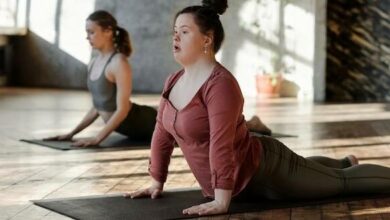4 balance-enhancing exercises seniors can do at home
Seniors struggle with a variety of problems that can have a negative impact on their mobility. With advancing age, most people experience joint paint due to arthritis and an overall decrease in muscle mass. Age-related medical conditions, such as Alzheimer’s disease, Parkinson’s disease, osteoporosis, vision loss and heart disease, as well as the prescription medications used to treat them can also cause dizziness, weakness and changes in cognition. When even just a few of these factors combine, it significantly increases a senior’s fall risk.
According to the Centers for Disease Control and Prevention (CDC), one in four Americans aged 65 and older falls each year, resulting in three million emergency room visits, 800,000 hospitalizations and 28,000 deaths. Each fall doubles a senior’s risk of falling again and increases the likelihood of an early death. When it comes to serious injuries, more than 95 percent of hip fractures are caused by falls.
Fortunately, practicing a few gentle at-home exercises on a regular basis can help seniors enhance their strength, balance and coordination and decrease their risk of falling. Best of all, caregivers and seniors can perform these moves together to safeguard their mobility and prevent accidents.
The following movements should be done next to another person serving as a spotter, a sturdy chair or a hand rail that can be used for balance in case you or your loved one becomes unsteady. Avoid engaging in any exercises that seem overly challenging for either of you, unless a doctor has given his or her approval.
Tightrope Walk
Just like a tightrope walker in a circus, this exercise involves holding your arms straight out from your sides, parallel to the floor. With your arms out, walk in a straight line, pausing for one or two seconds each time you lift your back leg off the ground. Take between 15 and 20 steps this way. While walking, keep your head straight and look at a fixed spot in front of you to help maintain balance.
Rock the Boat
For this exercise, begin by placing your feet hip-width apart. Make sure that each foot feels like it’s pressing into the ground with the same amount of force. This will ensure that your weight is evenly distributed across both legs. With your shoulders back and head level, slowly transfer your weight to one side, lifting the opposite foot off the ground. Hold your leg off the ground for as long as you can, but no longer than 30 seconds. Then, slowly transfer your weight back onto both feet and repeat the process on the opposite side. Aim to repeat this process five times on each side initially and work up to more repetitions as your balance and strength improve.
Heel-Toe Walk
This exercise involves placing one foot directly in front of the other so that the heel of your front foot and the toes of your back foot are touching with each step. Depending on your level of flexibility, you may not be able to get your heel and toes to completely touch, but that’s fine. Just try to get them as close as you can without any discomfort. Take between 15 and 20 steps this way. As with the tightrope walk, keeping your eyes fixed on a point in front of you will help you remain stable.
Flamingo Stand
This one is pretty simple. You basically just stand on one leg with the other leg extended out in front of you while holding on to the back of a chair for stability. Start off standing on one leg for ten seconds, and then repeat on the other leg. Aim to repeat this on each leg five to ten times. You and your loved one may find that it’s less taxing to stand on one leg than the other, but this is normal. Just continue exercising both sides equally to help build strength and confidence on the weaker side. It’s important to maintain good posture (keep your shoulders back, your back straight and your head up) while doing this exercise.
Starting out with these simple exercises can provide an excellent foundation for other strength- and balance-building fitness routines like Tai Chi, gentle yoga, aquatic exercise and much more. Just be sure to clear any new physical activities with a physician and avoid overexerting yourself in the beginning.
AMAC Urges Seniors to Enter Into a ‘Fitness Protection Program’







